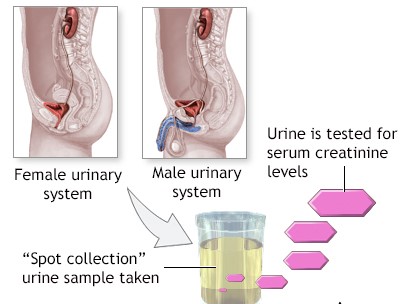A nurse is reviewing the laboratory reports of a client who is undergoing nutritional screening due to a risk for chronic kidney disease. The nurse should identify that which of the following results indicates the need for further assessment?
Serum creatinine 3.5 mg/dL
Hematocrit 45%
Blood urea nitrogen 18 mg/dL
Sodium 140 mEq/L
The Correct Answer is A
Choice A reason: Serum creatinine 3.5 mg/dL is high and indicates the need for further assessment. Creatinine is a waste product of muscle metabolism that is filtered by the kidneys. High creatinine levels can indicate kidney damage or impaired renal function.
Choice B reason: Hematocrit 45% is within the normal range (37-47% for women, 40-50% for men), and it does not indicate the need for further assessment. Hematocrit is the percentage of red blood cells in the blood. Low hematocrit levels can indicate anemia, bleeding, or hemolysis.
Choice C reason: Blood urea nitrogen 18 mg/dL is within the normal range (7-20), and it does not indicate the need for further assessment. Blood urea nitrogen is a waste product of protein metabolism that is filtered by the kidneys. High blood urea nitrogen levels can indicate dehydration, kidney damage, or high protein intake.
Choice D reason: Sodium 140 mEq/L is within the normal range (135-145), and it does not indicate the need for further assessment. Sodium is an electrolyte that helps maintain fluid balance, blood pressure, and nerve impulses. Low or high sodium levels can cause confusion, seizures, or coma.

Nursing Test Bank
Naxlex Comprehensive Predictor Exams
Related Questions
Correct Answer is D
Explanation
Choice A reason: Skim milk is not an appropriate snack choice for a 9-month-old infant. Infants under 12 months of age should not consume cow's milk, as it can cause iron deficiency, gastrointestinal bleeding, and allergic reactions. Infants should be breastfed or formula-fed until they are 12 months old.
Choice B reason: Unsalted popcorn is not an appropriate snack choice for a 9-month-old infant. Popcorn is a choking hazard for infants, as it can easily get stuck in their throat or lungs. Infants should not be given any hard, round, or sticky foods that can cause choking.
Choice C reason: Raw carrots are not an appropriate snack choice for a 9-month-old infant. Raw carrots are also a choking hazard for infants, as they are hard and difficult to chew and swallow. Infants should be given soft, cooked, or pureed vegetables that can be easily mashed with their gums.
Choice D reason: Graham crackers are an appropriate snack choice for a 9-month-old infant. Graham crackers are soft, easy to chew and swallow, and provide carbohydrates and energy. They can also help infants practice their self-feeding skills and finger coordination.
Correct Answer is D
Explanation
Choice A reason: BMI of 18.5 is at the lower end of the normal range (18.5-24.9), but it does not indicate severe malnutrition.
Choice B reason: Potassium 3.7 mEq/L is within the normal range (3.5-5.0), and it does not indicate electrolyte imbalance due to malnutrition.
Choice C reason: Phosphorus 3.5 mg/dL is within the normal range (2.5-4.5), and it does not indicate mineral deficiency due to malnutrition.
Choice D reason: Albumin 2.5 g/dL is below the normal range (3.5-5.0), and it indicates protein deficiency due to malnutrition. Albumin is a major protein in blood plasma that helps maintain fluid balance, transport hormones, and fight infections. Low albumin levels can cause edema, weakness, infection, and poor wound healing.
Whether you are a student looking to ace your exams or a practicing nurse seeking to enhance your expertise , our nursing education contents will empower you with the confidence and competence to make a difference in the lives of patients and become a respected leader in the healthcare field.
Visit Naxlex, invest in your future and unlock endless possibilities with our unparalleled nursing education contents today
Report Wrong Answer on the Current Question
Do you disagree with the answer? If yes, what is your expected answer? Explain.
Kindly be descriptive with the issue you are facing.
